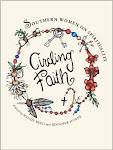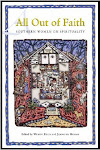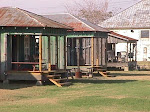
It was my good fortune/fate to serve on one of seven panels scheduled for the first “slot” (9:00 – 10:30 a.m.) on the first morning of the 2009 Southern Women Writers’ Conference in Berry, Georgia, September 24-26. I say “fate” because there were lots of folks still arriving, finding their way (on this 26,000-acre campus!) and registering on Thursday morning. The early birds were then dispersed amongst these seven panels, with only a small handful landing in the “Multimedia Room,” Ford 128.
The small “audience” lost significance as Tom Dasher of Berry College met the three of us—myself, Amy Pardo from Mississippi University for Women, and Eleanor Hershey Nickel from Fresno Pacific University in California—and we began to exchange stories. I laughed as Tom told us that he got caught up in reading my blog in preparation for introducing me, and accidently pushed something that began to print it… and only after 50 pages or more soaked up and wasted his ink did he, in frustration, unplug his printer.
Amy, Eleanor and I had corresponded by email prior to the conference, and it was really
 fun to participate with them on this panel. Amy is quite the techy, so when the audio-visual guy (who was very nice) couldn't make our jump drives connect to the system (we both had Power Points slides) tiny little Amy—in her shiny polished cotton pants, heels, and sleeveless ruffled blouse—just pulled the equipment out of the cabinet, got down on the floor and found the right ports for our jumps and voila! We were good to go.
fun to participate with them on this panel. Amy is quite the techy, so when the audio-visual guy (who was very nice) couldn't make our jump drives connect to the system (we both had Power Points slides) tiny little Amy—in her shiny polished cotton pants, heels, and sleeveless ruffled blouse—just pulled the equipment out of the cabinet, got down on the floor and found the right ports for our jumps and voila! We were good to go.Amy presented an academic paper about Sarah Ann Ellis Dorsey, a 19th century Natchez, Mississippi, writer. I thought about Barry Hannah’s critiques of our writing during our Wednesday afternoon sessions in Oxford this summer, when he would say, “Who cares?” and try to teach us that we have to make our readers care about the characters in our stories. Amy asked, “Why care?” about the privileged society of the 19th century south, noting that Dorsey was the first woman in the Academy of Science and was a model in breaking with privilege I order to create community… in order to actually help the oppressed.
Eleanor, a pop culture specialist, became interested in Jan Karon’s “Mitford novels” and the way she represents the South. Her comments on the “ambivalent regionalism” in Karon’s novels reflects, in my opinion, her lack of actual experience living as a Southerner. Or maybe there are actually sub-cultures in the South, because my experience growing up in Mississippi is completely different from the community Karon describes in her Mitford series, set in North Carolina. I did love one of her comments: “The South is diminishing due to consumerism, bad taste, and urban sprawl.” Lord, save us!
I followed Amy and Eleanor’s presentations, and the small group listening seemed to appreciate my essay, “Are These My People?” and I even ran into some of them at other venues throughout the weekend and they had told others about it, so that was a good sign.
 One of my favorite keynote speaker of the weekend followed close on the heels of my panel. Just before lunch on Thursday, Allison Hedge Coke, mixed-blood (native American Indian) poet and memoirist, gave what would end up being my favorite presentation of the entire conference. I loved her poetry, but purchased her courageous memoir, Rock, Ghost, Willow, Deer: A Story of Survival, and have only had time to read the first few pages, but I’m so hooked. Allison and her sister were raped and otherwise abused as children, and learned to dissociate. Their mom was schizophrenic. Allison said writing memoir is like shadow-boxing. I get that.
One of my favorite keynote speaker of the weekend followed close on the heels of my panel. Just before lunch on Thursday, Allison Hedge Coke, mixed-blood (native American Indian) poet and memoirist, gave what would end up being my favorite presentation of the entire conference. I loved her poetry, but purchased her courageous memoir, Rock, Ghost, Willow, Deer: A Story of Survival, and have only had time to read the first few pages, but I’m so hooked. Allison and her sister were raped and otherwise abused as children, and learned to dissociate. Their mom was schizophrenic. Allison said writing memoir is like shadow-boxing. I get that.Next, at the Thursday lunch session, Melissa Fay Greene spoke. This is a woman who has
 adopted five children in addition to having four biological children. One of her adopted sons, Jesse, is from Bulgaria. The other four are Ethiopian orphans who lost their parents to AIDS. Her book, There Is No Me Without You: One Woman’s Odyssey to Rescue Her Country’s Children (2007) is the story of Haregewoin, Teferra, an Orthodox Ethiopia woman who lost her own children but opened her home to over 300 foster children over the years.
adopted five children in addition to having four biological children. One of her adopted sons, Jesse, is from Bulgaria. The other four are Ethiopian orphans who lost their parents to AIDS. Her book, There Is No Me Without You: One Woman’s Odyssey to Rescue Her Country’s Children (2007) is the story of Haregewoin, Teferra, an Orthodox Ethiopia woman who lost her own children but opened her home to over 300 foster children over the years.  One of the afternoon panels that I chose to attend was “The Violent South,” and included Liz Thompson from the University of Memphis, presenting her thesis-in-progress: “Some Unheard of Thing: How Incest Became Convention in Southern Women’s Writing.” Liz and I hooked up later for lunch (panelist Casey Kayser from LSU and a friend of hers who studied at Rhodes in Memphis (sorry I can’t remember her name) and I was intrigued with her journey researching fiction and nonfiction writers who were abused. That seemed to be a theme all weekend.
One of the afternoon panels that I chose to attend was “The Violent South,” and included Liz Thompson from the University of Memphis, presenting her thesis-in-progress: “Some Unheard of Thing: How Incest Became Convention in Southern Women’s Writing.” Liz and I hooked up later for lunch (panelist Casey Kayser from LSU and a friend of hers who studied at Rhodes in Memphis (sorry I can’t remember her name) and I was intrigued with her journey researching fiction and nonfiction writers who were abused. That seemed to be a theme all weekend.Another panel, “Writing and Sustaining Domestic Arts,” included a presentation by Laura Sloan Patterson from Seton Hall, “Fashioning Another South and Another Self: O’Connor, Welty, Walker and the Creation of Clothing.” Her insightful comments about Flannery O’Connor’s dressing habits made me want to revisit my first effort at memoir (Dressing the Part) ... maybe some day….
During a coffee break Friday morning I got together with Jackson, Mississippi, native,
 Ellen Ann Fentress. We both grew up in Jackson (she still lives there) but she’s about five years younger, so we never met until the conference. Ellen Ann won the Emerging Writers Award for Creative Nonfiction (yep, the one I entered, but didn’t win, so I was happy a fellow Jacksonian won!) and we had a great time sharing our journeys.
Ellen Ann Fentress. We both grew up in Jackson (she still lives there) but she’s about five years younger, so we never met until the conference. Ellen Ann won the Emerging Writers Award for Creative Nonfiction (yep, the one I entered, but didn’t win, so I was happy a fellow Jacksonian won!) and we had a great time sharing our journeys.
Another encounter outside the official conference schedule was coffee later Friday night with Rebecca Phillips. I’ve known Rebecca’s parents and grandparents for years—her grandfather, Fr. Andrw Moore, is an Orthodox priest, and his wife, Dannie, and I have been friends for many years. Rebecca is a sophomore at Berry College, so it was fun to hear about her life and about the school from a student’s point of view. What a great school! Now I’m promoting it for friends who have teenagers who are beginning to look at colleges.
Friday’s luncheon speaker, Judith Ortiz Cofer, brought yet another element to the
 table. As a native Puerto Rican now living in Georgia, Judith has published lyrical prose and poetry as well as a book about writing. Her presentation was full of humor and inspiration. “Our journey towards ‘casa,’—home—defines us, and we are not whole and complete until we find that home.” Her words confirmed the importance of my current search for “my people.”
table. As a native Puerto Rican now living in Georgia, Judith has published lyrical prose and poetry as well as a book about writing. Her presentation was full of humor and inspiration. “Our journey towards ‘casa,’—home—defines us, and we are not whole and complete until we find that home.” Her words confirmed the importance of my current search for “my people.” 
Another panel I enjoyed was “Flannery O’Connor’s South: Race and Religion.” Sara Gordon, an expert on O’Connor, brought a lot to the table at the panel, as well as giving a plenary session just before dinner on Friday. I was happy to sit with Sarah at lunch on Friday, where she autographed my copy of her scholarly work, Flannery O’Connor: The Obedient Imagination.
One of Sarah's comments really hit a chord with me: “We
 must recognize that we are broken if we are going to be fixed—there must be an element of the physical present—which is true in all of O’Connor’s works. She rejects the Manichean heresy, that material things are sinful.” I also love this about O’Connor… the way she infuses her art—her fiction—with her very physical faith, which is what I’m trying to do with my own writing. She has set the bar high.
must recognize that we are broken if we are going to be fixed—there must be an element of the physical present—which is true in all of O’Connor’s works. She rejects the Manichean heresy, that material things are sinful.” I also love this about O’Connor… the way she infuses her art—her fiction—with her very physical faith, which is what I’m trying to do with my own writing. She has set the bar high.At dinner Friday night I was blown away by keynote speaker Connie May Fowler. I’d been chatting with Connie May on Facebook for a while, but had no idea how dynamic she would be as a speaker. I haven’t read her work yet, but she’s now on my list—especially her memoir, When Katie Wakes. Another battered/abused woman, Connie May founded Women
 With Wings Foundation, and has done much to help educate and heal this epidemic in our world. In her fictionalized memoir, Before Women Had Wings, she talks about how her craving for sugar is bred by the sadness in her life.
With Wings Foundation, and has done much to help educate and heal this epidemic in our world. In her fictionalized memoir, Before Women Had Wings, she talks about how her craving for sugar is bred by the sadness in her life. She talked about how she learned to dissociate when violence was happening, but also to pay attention to the details, so that she could write them. Her writing—her art—has been her healing. But as a child she disappeared into books. The world of books provided not only an escape but a role model and hope. One of her favorites was Strawberry Girl by Lois Linsky, about a poor family in Florida who, although they were poor, had love. She imagined herself in that family. Her sister, on the other hand, has chosen to block out her childhood memories, and has starved herself with anorexia.
One affect of abuse is to make a woman feel worthless, and even guilty when we experience success. When Connie May’s book, Before Women Had Wings, was made into a movie by Oprah (and Connie May was asked to write the screen version) she thought, “I don’t deserve to be there… to get to do this.”
Connie May encouraged us, as women and as writers, to “operate as an artist first” or
 your story won’t be successful.” Her words reminded me of Scott Morris, who told us at the Yoknapatawpha Writers Workshops in Oxford, Mississippi in 2008 that we have to “get up and above our lives” in order to write them as art. She said that “stories save lives and we must keep writing but do it as artists and not as confessors.”
your story won’t be successful.” Her words reminded me of Scott Morris, who told us at the Yoknapatawpha Writers Workshops in Oxford, Mississippi in 2008 that we have to “get up and above our lives” in order to write them as art. She said that “stories save lives and we must keep writing but do it as artists and not as confessors.”She also told us that “your abuser tries to steal your voice, but speaking or writing is the way to find your voice.”
One more concept that she shared is that of having a “shadow book”—someone else’s book that puts you into the river of shared life with others on the journey. I really identified with that, and now Connie May’s memoirs will join my growing stack of “shadow books.”
 Open Mic at 333 on Broad on Friday night was so much fun… about two dozen writers read from their work while we enjoyed drinks and the ambience of this quaint little bar. Afterwards some of us enjoyed the music and dancing upstairs, a perfect break from the intensity of an incredible but “heavy” weekend. I’ll post about our overnight visit with relatives in Atlanta and our time in Savannah (where I’m posting from now) with our son, Jonathan, soon… but for now I’ll end with my renewed resolve to do as my heroine, Flannery O’Connor said: “You have got to learn to paint with words.” And I think Sarah Gordon would add... to do it with an obedient imagination.
Open Mic at 333 on Broad on Friday night was so much fun… about two dozen writers read from their work while we enjoyed drinks and the ambience of this quaint little bar. Afterwards some of us enjoyed the music and dancing upstairs, a perfect break from the intensity of an incredible but “heavy” weekend. I’ll post about our overnight visit with relatives in Atlanta and our time in Savannah (where I’m posting from now) with our son, Jonathan, soon… but for now I’ll end with my renewed resolve to do as my heroine, Flannery O’Connor said: “You have got to learn to paint with words.” And I think Sarah Gordon would add... to do it with an obedient imagination.

























































































